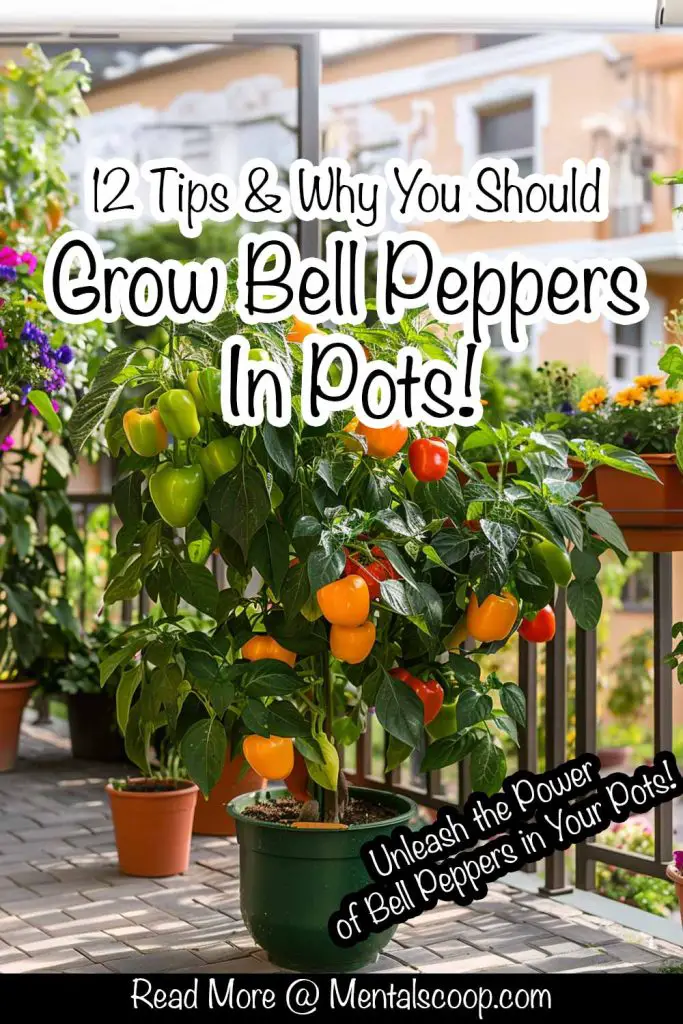12 Tips & Why You Should Grow Bell Peppers In Pots!

Are you an aspiring gardener, eager to cultivate your own fresh produce but constrained by limited space? Look no further than bell peppers!
These vibrant, versatile vegetables not only add flavor and color to your culinary creations but also thrive in containers, making them an ideal choice for urban gardeners, apartment dwellers, and anyone with a small yard.
In this comprehensive guide, we’ll delve into 12 essential tips for successfully growing bell peppers in pots, while also exploring the myriad reasons why they deserve a prime spot in your garden.
Select the Right Container
Choosing the appropriate container is crucial for the successful growth of bell peppers. Opt for pots that are at least 12 inches in diameter and depth to accommodate the extensive root system of pepper plants.
Additionally, ensure the containers have drainage holes to prevent waterlogging, which can lead to root rot.
Use Quality Potting Mix
Invest in a high-quality potting mix specifically formulated for container gardening. Look for mixes that are lightweight, well-draining, and rich in organic matter to provide optimal growing conditions for your bell peppers.
Provide Adequate Sunlight
Bell peppers thrive in full sunlight, so choose a sunny location for your container garden. Aim for at least 6-8 hours of direct sunlight per day to promote healthy growth and bountiful yields.
Start with Healthy Seedlings
For novice gardeners or those short on time, starting with healthy seedlings is recommended. Purchase young bell pepper plants from a reputable nursery or garden center, ensuring they are free from pests and diseases.
Proper Watering
Maintain consistent moisture levels in the soil by watering your bell pepper plants regularly. However, avoid overwatering, as this can lead to waterlogged soil and root rot. Allow the top inch of soil to dry out between watering sessions.
Fertilize Regularly
Bell peppers are heavy feeders and benefit from regular fertilization throughout the growing season. Apply a balanced fertilizer high in phosphorus and potassium to promote flowering and fruit development. Follow the manufacturer’s instructions for application rates and frequency.
Support Your Plants
As bell pepper plants grow, they may become top-heavy with the weight of their fruit. Provide support by staking or caging your plants to prevent them from bending or breaking under the weight. This also helps improve air circulation and reduces the risk of disease.
Prune for Productivity
Encourage bushier growth and increased fruit production by pruning your bell pepper plants. Pinch off the topmost growing tips when the plants reach a height of 12-18 inches to stimulate lateral branching. Remove any yellowing or diseased leaves to maintain plant health.
Watch for Pests and Diseases
Keep a close eye on your bell pepper plants for signs of pests such as aphids, thrips, or caterpillars, as well as common diseases like powdery mildew or bacterial spot. Promptly address any issues with organic pest control methods or fungicides to prevent them from spreading.
Harvest at the Right Time
Patience is key when it comes to harvesting bell peppers. Wait until the fruits reach their mature color—whether green, yellow, orange, or red—before picking them from the plant. Use a sharp pair of scissors or pruners to snip the peppers from the stem, being careful not to damage the plant.
Culinary Versatility
One of the greatest joys of growing bell peppers is the culinary versatility they offer. Incorporate freshly harvested peppers into a wide range of dishes, from salads and stir-fries to soups, stews, and salsas.
Their crisp texture and sweet flavor enhance both savory and sweet recipes, making them a kitchen essential.
Health Benefits
Beyond their culinary appeal, bell peppers are packed with essential nutrients and antioxidants that promote health and well-being. They are an excellent source of vitamin C, vitamin A, vitamin B6, and folate, as well as dietary fiber and phytonutrients.
Including bell peppers in your diet can support immune function, improve digestion, and reduce the risk of chronic diseases.
In conclusion, growing bell peppers in pots is a rewarding and accessible endeavor for gardeners of all skill levels. By following these 12 tips and embracing the numerous benefits of cultivating bell peppers, you can enjoy a bountiful harvest of fresh, flavorful produce right outside your doorstep.
So roll up your sleeves, grab your gardening gloves, and get ready to experience the joy of growing your own bell peppers in pots!

More interesting articles you may be interested in reading:

